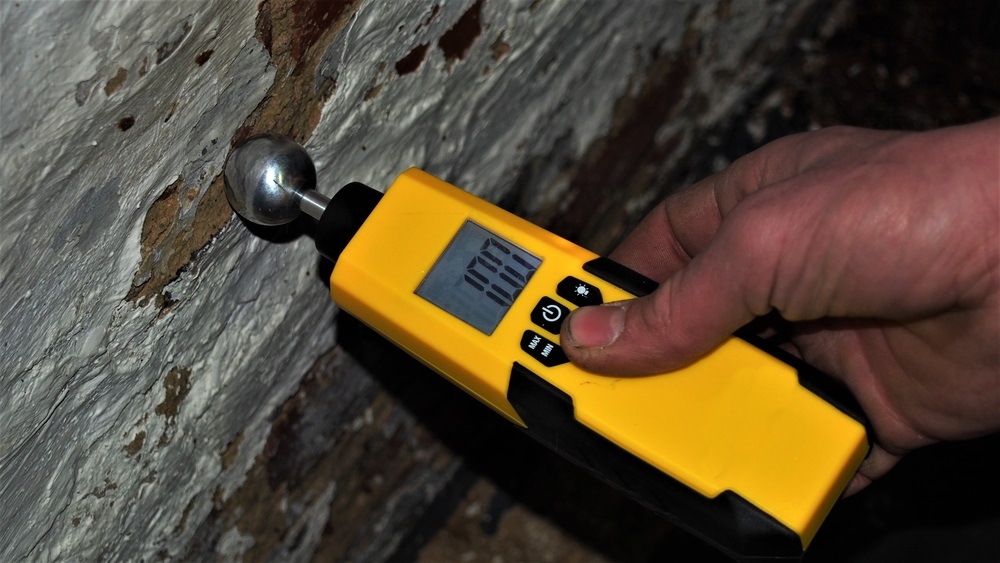When it comes to construction, determining the correct moisturecontent of wetted building materials and analyzing correspondinglocations, orientations and patterns is of imminent value toforensic engineers and building scientists. As many buildingdamages relate to insurance claims and construction defect/subrogation lawsuits, legal challenges to the accuracy of measuredmoisture content (MC) have arisen.
|Moisture in the built environment
Various types of leaks may expose the built environment to arange of potential MC. A common roof or window leak causeslow-volume moisture intrusion that subjects the interior buildingcomponents to an intermittent source and corresponding elevated MC,while a sudden plumbing leak may result in near saturatedconditions.
|Gypsum board drywall and wood building products are nearuniversal in modern construction. Extended moisture exposure tointerior building components causes fungal growth, deterioration,and eventual weakening and/or failure of the material.
|A wide range of possible moisture contents within a buildingsubjected to a leak prompts the question as to the precision ofmoisture meters at a range of contents, substrates, and which meteris more effective under which specific circumstance.
|Study materials and methods
An independent study was conducted to establish the levelof precision of common moisture meters used to quantify and measuremoisture content in building components. The study tested fourdifferent brand moisture meters in gypsum and wood substrates atnormal, high and saturated moisture contents. After specifiedperiods of wetting, four different brands of moisture meter wereutilized to determine the moisture content of specimens by manualpin type measurements. The results were compared againstlaboratory-obtained moisture content to assess the accuracy ofmeters in each substrate at a varying range of MC.
- Meter E had a retail price of $320.
- Meter G had a retail price of $35.
- Meter S had a retail price of $599.
- Meter T had a retail price of $342.
Related: Alerting your clients to a major, and yetunderappreciated, risk
||
A moisture meter used to determine dampness levels in aconcrete wall. (Photo: Shutterstock)
|Study findings
Different brand meters are designed to be accurate withinvarying ranges of moisture content. Moisture meters should be usedwithin their manufacturer specified range of moisture content.Values obtained outside of this range may not be accurate.
|Wood
- All meters functioned well at low moisture content, within avery narrow margin of error.
- All meters functioned well in moderately wet conditions, withina two to six percent margin of error.
- Meter T was the most accurate meter over the entire range ofmoisture contents, and generally followed the general trend oflaboratory obtained MC. As Meter T had the longest pins, pin lengthmay have enabled more accurate measurements.
- In low moisture content, Meter G functioned precisely; at a0.28% deviation from laboratory obtained MC.
- Meters G and S exhibited a reasonable margin of error at a highmoisture content.
- Meter E was not accurate at high moisture content.
Gypsum
|All meters functioned well at low moisture content within a verynarrow margin of error. Due to variations in materialcharacteristics, meters exhibit some level of inherent inaccuracyin composite materials such as modern gypsum board (drywall). Thinkof drywall as a paper and gypsum sandwich with gypsum in themiddle.
|Consequently, in moderately wet and saturated conditions, metersmay have overestimated the precise MC by measuring the saturationin the outer paper facing and not registering the precise MC in thegypsum core.
|In moderately wet and saturated conditions, Meter T may haveundergone a random error as it failed to detect wet conditions andfive of the six measurements were the same numerical value. Such anerror represents the need to verify calibration of the meter afterpurchase and on a regular basis during use. Currently, Meter S isthe only meter that comes stock with an electrode to verifyaccurate calibration.
|Ironically, Meter G (least expensive) and Meter S (mostexpensive) followed the same exact trend, returning 100% wet valuesin moderately wet and saturated conditions, which were not correctmoisture contents, but were both satisfactory in detecting wetconditions. It is also apparent from this data that price may notbe the best indicator of measurement accuracy.
|These findings are valuable for claims professionals, engineersand others who are trying to determine the scope of damagefollowing a water damage event. Knowing what types of metersprovide the most accurate readings enables those conductinginspections to choose the best tools for their toolbox.
|Abel Crean ([email protected]) is a forensicengineer in the greater Miami area for GeoHazards, Inc. He hasperformed research on ultra-high-performance concrete, infraredthermography, and moisture in the builtenvironment.
|Related: 5 tips for claims pros inventorying water-damagedsites
Want to continue reading?
Become a Free PropertyCasualty360 Digital Reader
Your access to unlimited PropertyCasualty360 content isn’t changing.
Once you are an ALM digital member, you’ll receive:
- All PropertyCasualty360.com news coverage, best practices, and in-depth analysis.
- Educational webcasts, resources from industry leaders, and informative newsletters.
- Other award-winning websites including BenefitsPRO.com and ThinkAdvisor.com.
Already have an account? Sign In
© 2024 ALM Global, LLC, All Rights Reserved. Request academic re-use from www.copyright.com. All other uses, submit a request to [email protected]. For more information visit Asset & Logo Licensing.








